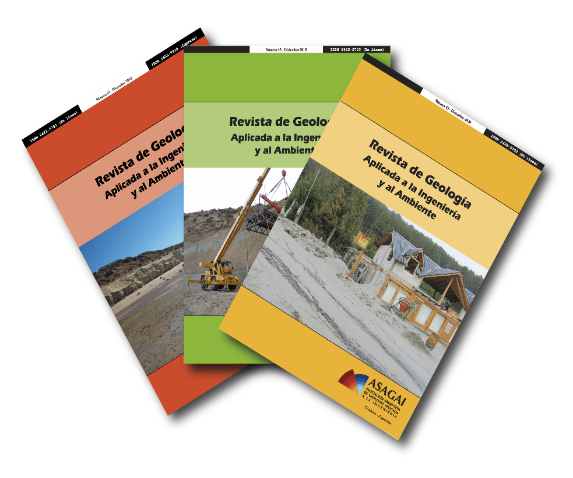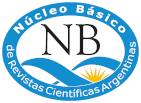Effect of fracturing on the petrophysical sampling of cores for the estimation of porosity and permeability
DOI:
https://doi.org/10.59069/24225703ee012Keywords:
lithological cores, petrophysical studies, fractures, naturally fractured reservoirsAbstract
Petrophysical sampling is an essential tool to determine the porosity and permeability of a reservoir rock in order to understand its storage conditions, recovery and productivity of the fluids it contains, and thus assess the economic potential of an exploratory project. However, the limited size of the different types of cores conditions the true validity of their determinations when they are extrapolated to the rest of the reservoir. The mechanical limitation in the extraction of cores (plugs) in lithological areas without fractures fails to reflect the behaviour of the rock group. The porosity and permeability measurements obtained from laboratory samples, when only the undeformed rock is considered, are significantly lower than the overall values when the contribution of fractures is incorporated. In this study, the influence of fracturing in the petrophysical sampling of heterogeneous lithologies of cores for the determination of porosity and permeability in reservoir rocks is investigated. We discuss how fractures can affect petrophysical measurements and how these can impact the accuracy of porosity and permeability estimates in reservoir evaluation. The results obtained provide valuable petrophysical information to improve sampling techniques in areas with the presence of fractures for better characterization of reservoirs and more informed decision making in the oil and gas industry.
References
Andersen, M.A., Duncan, B. y McLin, R. (2013). Los núcleos en la evaluación de formaciones. Oilfield Review ,25 (2), 16-27.
Anderson, G. (1975). Coring and core analysis. Petroleum Publ. Co., 200 pp. Tulsa.
Aguilera, R. (1995). Naturally fractured reservoir. PennWell Publishing Co. (2°Ed.), Tulsa, Oklahoma. ISBN 0-87814-449-8
Ahmed, T. (2006). Reservoir engineering handbook. Gulf Professional Publishing (3° Ed.), 1376 pp. ISBN: 9780080480688
Amaefule, J., Kersey, D., Marschall, D., Powell, J., Valencia L. y Keelan, D. (1988). Reservoir description: A practical synergisyic engineering and geological approach based on analysis of core data. Society of Petroleum Engineers 18167.
Bjorlykke, K. (2014). Relationships between de positional environments, burial history and rock properties. Some principal aspects of diagenetic process in sedimentary basins. Sedimentary Geology, 301, 1-14.
Bratton, T., Dao Viet Canh, Nguyen Van Que, Nguyen V. Duc, Gillespie, P., Hunt, D., Bingjian Li, Marcinew, R., Satyaki Ray, Montaron, B., Nelson, R., Schoderbek, D. y Sonneland, L. (2006). La naturaleza de los yacimientos naturalmente fracturados. Oilfield Review, 4-25.
Cone, M.P. y Kersey, D.G. (1993). Porosity. In: Morton-Thompson, D., Woods, A.M. (eds.), Development Geology Reference Manual, Part 5 Laboratory Methods. American Association of Petroleum Geologists, Methods in Exploration Series, 10, 204-209.
Ehlig-Economides, C.A., Taha, M., Marin, H.D., Novoa, E. y Sánchez, O. (2000). Drilling and completion strategies in naturally fractured reservoirs. Society of Petroleum Engineers, International Petroleum Conference and Exhibition in Mexico. OnePetro.
Ekstrom, M.P., Dahan, C.A., Chen, M.Y., Lloyd, P.M. y Rossi, D.J. (1987). Formation imaging with microelectrical scanning arrays. Log Analyst 28, 294-306.
Fjær, E., Holt, R., Horsrud, P. y Raaen, A. (2008). Petroleum related rock mechanics. 2nd Edition, Elsevier. ISBN: 9780080557090
Friedman, M. (1967). Description of rocks and rock masses with a view to their physical and mechanical behavior. 1st Int. Congress Rock Mechanics, Proceedings 3, 181-197.
Ganat, T.A. (2020). Fundamentals of reservoir rock properties. Springer Nature. DOI.org/10.1007/978-3-030-28140-3
Golf-Racht, T.D. van (1982). Fundamentals of fractured reservoir engineering. Elsevier, 657 pp. ISBN: 9780080868660
Heap, M., Reuschlé, T., Baud, P., Renard, F. y Iezzi, G. (2018). The permeability of stylolite-bearing limestone. Journal of Structural Geology, 116. DOI: 10.1016/j.jsg.2018.08.007
Klinkenberg, L.J. (1941). The permeability of porous media to liquids and gases. Drilling and Production Practice, 200–213.
Kubik, W. y Lowry, P. (1993). Fracture identification and characterization using Cores, FMS, CAST, and Borehole Camera: Devonian Shale, Pike County, Kentucky. Society of Petroleum Engineers 25897.
Laongsakul, P. y Dürrast, H. (2011). Characterization of reservoir fractures using conventional geophysical logging. Songklanakarin J. Sci. Technol. 33 (2), 237-246.
Parsons, R.W. (2007). Permeability of idealized fractured rock. Society of Petroleum Engineers, 6, 126-136.
Pijush, P., Zoback, M. y Hennings, P. (2007). Fluid flow in a fractured reservoir using a geomechanically - Constreined fault zone damage model for reservoir simulation. Society of Petroleum Engineers, Annual Technical Conference and Exhibition. DOI: 10.2523/110542-MS
Poston. S. y Laprea-Bigott, M. (2023). Practical Aspects of Waterflooding. Society of Petroleum Engineers, SPE Books (www.onepetro.org),
Mazzullo, S.J. y Chilingarian, G.V. (1992). Diagenesis and origin of porosity. In: Chilingarian, G.V., Mazzullo, S.J. y Rieke, H.H. (eds.),
Carbonate reservoir characterization: A geologic-engineering analysis, Part I. Elsevier Publ. Co., Developments in Petroleum Science, 30, 199-270. Amsterdam.
Miquel González, L, Ortiz Rabell, G. y Castro Castiñeira, O. (2017). Aplicación de la técnica de tomografía axial computarizada para mejorar la caracterización de las rocas sello y reservorio de los yacimientos petroleros cubanos. Boletín de Ciencias de la Tierra, (41), 72-79.
Naides, C. (2020). Como construir un modelo petrofísico, del poro al perfil. Society of Petroleum Engineers, 49pp.
Nelson, R.A. (2001). Geologic analysis of naturally fractured reservoirs. Gulf Professional Publishing, 8-43.
Rossello, E.A. (2017). Influencia del soterramiento en la calidad de los reservorios de hidrocarburos: fundamentos, metodologías prácticas de reconocimiento e interpretación. Asociación Geológica Argentina, Revista, 75 (2), 722-735.
Rossello, E.A. (2018). Interpretaciones estructurales dinámicas a partir del análisis de ovalización (break-outs) de pozos: aplicaciones a perforaciones en la Formación Vaca Muerta (Cuenca Neuquina, Argentina). Revista de la Asociación Geológica Argentina, 75 (2), 252-264.
Rossello, E.A. y Saavedra, J.L. (2019). Contribution of bedding to the petrophysical characterization of naturally fractured reservoirs: Example of the Matachines fields, Upper Magdalena Valley. Boletín de Geología, 46, 23-49.
Rushing, J.A., Newsham, K.E., Lasswell, P.M., Cox, J.C. y Blasingame, T.A. (2004). Klinkenberg -corrected permeability measurements in tight gas sands: Steady-state versus unsteady-state techniques. SPE 89867, Conferencia y Exhibición Técnica Anual, Houston.
Saidi, A.M. (1987). Reservoir engineering of fractured reservoirs. Total Ediciones, 864 pp., Paris.
Schlumberger (1987. Principios y aplicaciones de la interpretación de registros. https://es.scribd.com/document/95473890/
Serag El Din, S., Dernaika, M.R., Al Hosani, I., Hannon, L., Skjæveland, S.M. y Kalam, M.Z. (2010). Whole core versus plugs: Integrating log and core data to decrease uncertainty in petrophysical interpretation and STOIP calculations. Society of Petroleum Engineers, 18 pp. SPE 137679
Serra, O. (2008). Well Logging Handbook. Technip Editions, 604 pp., Paris.
Stearns, D.W. y Friedman, M. (1972). Reservoirs in fractured rock. American Association of Petroleum Geologists, Memoir, 16, 82-106. DOI.org/10.1306/M16371C8
Tiab, D. y Donaldson, E.C. (2004). Petrofísica. Elsevier, 914 pp. Oxford, UK.
Warren, J.E. y Root, P.J. (1963). The behavior of naturally fractured reservoirs. Society of Petroleum Engineers, Journal 3 (03), 245-255. DOI.org/10.2118/426-PA
Zoback, M.D. (2006). Reservoir Geomechanics. Cambridge University Press. 449 pp. DOI.org/10.1017/CBO9780511586477
Downloads
Published
Issue
Section
License
Copyright (c) 2023 Eduardo Antonio Rossello, Marcelo Laprea-Bigott

This work is licensed under a Creative Commons Attribution-NonCommercial-ShareAlike 4.0 International License.
Attribution - Non-Commercial - Share Alike (by-nc-sa): No commercial use of the original work or any derivative works is permitted, distribution of which must be under a license equal to that governing the original work.










